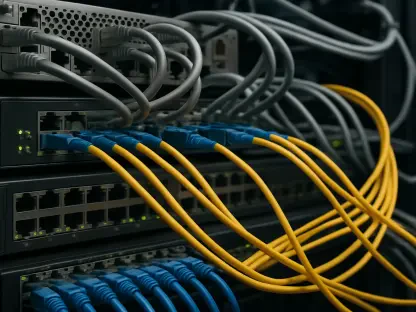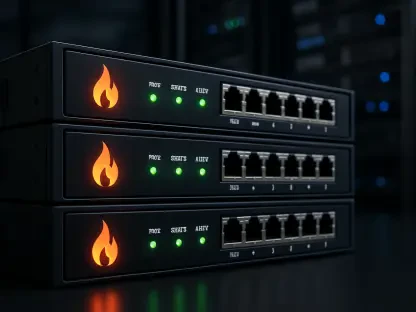Intel has made a significant impact at the Mobile World Congress (MWC) 2025 in Barcelona, Spain, with the introduction of the Intel® Xeon® 6 system-on-chip (SoC). This new innovation aims to revolutionize the telecommunications industry by enhancing AI RAN performance and energy efficiency. The announcement comes as the industry experiences transformative shifts driven by the convergence of AI and 5G technologies, which are reshaping networks and redefining connectivity standards. These advancements offer significant new opportunities yet also present several challenges, including high capital expenditures, security concerns, and the integration of modern systems with existing legacy frameworks.
Groundbreaking AI and 5G Integration
The telecommunications sector is undergoing substantial changes due to the convergence of AI and 5G technologies. These advancements are reshaping networks and redefining connectivity standards, offering new opportunities and challenges for operators. Intel’s Xeon 6 SoC is designed to address these challenges by providing a substantial increase in RAN capacity and performance-per-watt. The integration of AI acceleration features, such as Intel’s Advanced Vector Extensions (AVX) and Advanced Matrix Extensions (AMX), plays a crucial role in this enhancement. The new SoC promises up to a 2.4x increase in RAN capacity and up to 70% better performance-per-watt compared to its predecessors.
These improvements could significantly ease the pressure on operators to balance performance against energy consumption—a major consideration as networks become more complex and data demands escalate. The AI acceleration features in the Xeon 6 SoC are particularly noteworthy, enabling up to a 3.2x boost in AI RAN performance when compared to previous generations. By integrating such advanced capabilities directly into the chip, Intel is setting a new standard for network performance and efficiency.
Enhanced Connectivity and Performance
The Xeon 6 SoC boasts eight integrated Ethernet ports with a total throughput of up to 200 gigabits per second (Gbps). This significant improvement enhances the connectivity capabilities of the SoC, making it a valuable asset for operators seeking to streamline their infrastructure. The architecture of the Xeon 6 allows operators to consolidate their server infrastructure, drastically reducing the server footprint needed to deploy high-capacity RAN networks.
This consolidation leads to optimized total cost of ownership (TCO) and improved energy efficiency, cementing the Xeon 6 as a practical solution for modern networks. Consolidating server infrastructure not only reduces physical space requirements but also translates into considerable cost savings. Fewer servers mean lower maintenance costs, reduced cooling requirements, and a smaller environmental footprint. For network operators, this optimization is crucial, as it allows them to scale their services more effectively while simultaneously combating rising energy costs.
Moreover, the Xeon 6 SoC’s enhanced performance capabilities ensure that these benefits do not come at the expense of service quality, providing a robust solution for the next generation of telecommunications needs.
Media Transcoding Innovation
Intel’s Media Transcode Accelerator, integrated within the Xeon 6 SoC, is the first of its kind in the industry. This innovation delivers up to a 14.25x performance-per-watt gain for video transcoding, aiding video service providers in offering near-real-time experiences for live events while reducing power consumption. This development is particularly beneficial for video service providers looking to enhance their offerings while maintaining energy efficiency.
The Media Transcode Accelerator sets a new standard for performance and power consumption in the industry, highlighting Intel’s commitment to advancing technology and environmental sustainability. Video service providers have long struggled with the dual challenges of meeting high-performance standards and managing operational costs. With the Media Transcode Accelerator, Intel has addressed these issues comprehensively. The integrated accelerator not only improves transcoding efficiency but also significantly reduces energy consumption, which can have substantial financial implications over time.
For operators, this dual benefit is a game-changer, as it enables them to provide superior service quality without incurring prohibitive costs. Furthermore, the near-real-time capabilities of the accelerator mean that end-users experience minimal latency, an essential feature for live event broadcasting and other time-sensitive applications.
Advanced Security Measures
With the increasing data generation at the network edge, security is a top priority. The Xeon 6 SoC includes advanced security measures to ensure secure, zero-trust connections across the edge-to-cloud ecosystem. These security features are essential in maintaining the integrity and confidentiality of data, addressing the growing concerns related to data security in the telecommunications industry.
Advanced security measures embedded within the Xeon 6 SoC ensure that data remains secure as it travels across various network layers, thereby reinforcing trust in modern, integrated solutions. The focus on zero-trust security models is particularly significant given the rising frequency of cyber threats targeting telecom networks. By embedding advanced security features directly into the SoC, Intel has provided operators with a robust defense mechanism against potential breaches.
This proactive approach to security is essential in a landscape where vulnerabilities can lead to severe operational disruptions and data breaches. The secure, zero-trust connections facilitated by the Xeon 6 SoC allow operators to maintain high levels of service reliability without compromising on security, ensuring that data integrity remains uncompromised.
Industry Collaborations and Success Stories
Intel’s collaborations with industry leaders and telecommunication operators have yielded positive results. Vodafone’s initial OpenRAN deployments and AT&T’s partnership with Ericsson and Intel highlight the competitive edge of networks built on the Xeon 6 SoC. These collaborations underscore the SoC’s capabilities in delivering enhanced performance and efficiency, driving industry-wide adoption and setting new benchmarks for modern telecommunications.
The success stories from these partnerships demonstrate the tangible benefits that operators can achieve by leveraging Intel’s innovations. Samsung is leveraging the Xeon 6 SoC to enhance performance and energy efficiency, accelerating AI integration across RAN applications. Verizon, for example, is working on a next-gen high-compute-density vRAN server based on the Xeon 6, promising doubled RAN compute capacity and superior energy efficiency. Such initiatives indicate that leading telecom operators are eager to adopt advanced technologies to stay competitive and meet evolving customer demands.
By incorporating the Xeon 6 SoC into their infrastructure, these operators can offer enhanced services while maintaining operational efficiency and sustainability.
Partner Contributions to Open RAN and AI RAN Innovations
Partner firms such as Ericsson and Nokia are contributing to the advancement of Open RAN and AI RAN innovations using the Xeon 6 SoC. Ericsson has achieved its first Cloud RAN call on Xeon 6, powered by Dell servers, while Nokia has managed a significant reduction in run-time power consumption for its 5G Packet Core solution. These collaborations demonstrate the widespread adoption and success of the Xeon 6 SoC in the industry, highlighting its impact on modern telecommunications infrastructure. The achievements of these partners emphasize the practical benefits and transformative potential of Intel’s latest technology.
Ericsson’s successful Cloud RAN call signifies a major milestone in the industry’s shift towards more flexible and programmable network architectures. By leveraging the Xeon 6 SoC, Ericsson has been able to demonstrate the viability of cloud-native RAN solutions that offer both scalability and efficiency.
Similarly, Nokia’s reduction in run-time power consumption for its 5G Packet Core solution showcases the significant energy savings that can be achieved with the Xeon 6 SoC. These advancements are not just theoretical but have real-world implications for network operators seeking to modernize their infrastructure while controlling operational costs.
Commitment to Sustainability
Intel’s commitment to sustainability is evident with the widespread adoption of the Xeon 6 SoC among 5G core solution vendors and telecom operators. The company’s Infrastructure Power Manager (IPM) software further enhances energy efficiency and expedites time-to-market for customers. Partner success stories, such as Ericsson’s 3.8x improvement in performance-per-watt through software optimizations and Samsung’s plans to release its next-generation Cloud Native Core featuring Xeon 6 processors, reflect Intel’s dedication to sustainability.
Through these initiatives, Intel has demonstrated that it is possible to achieve technological excellence without compromising on environmental responsibility. The adoption of sustainability-focused technologies is increasingly becoming a priority for telecom operators, driven by both regulatory pressures and consumer demand for greener solutions. By integrating advanced power management features and optimizing software, Intel ensures that its products contribute to reduced energy consumption and environmental impact.
This approach not only benefits operators in terms of cost savings but also aligns with broader global efforts to address climate change. Intel’s proactive stance on sustainability, exemplified by the widespread success of the Xeon 6 SoC, sets a powerful example for the industry and reinforces the company’s leadership in responsible innovation.
New Ethernet Controllers and Network Adapters
At the 2025 Mobile World Congress (MWC) in Barcelona, Spain, Intel unveiled the Intel® Xeon® 6 system-on-chip (SoC), marking a significant milestone in the telecommunications industry. This cutting-edge innovation is designed to enhance the performance and energy efficiency of AI RAN, promising to revolutionize telecommunications. The industry is amidst profound changes propelled by the fusion of AI and 5G technologies, which are transforming networks and redefining connectivity standards.
While these advancements bring exciting new opportunities, they also introduce several challenges. These include substantial capital expenditures, heightened security concerns, and the complex integration of new systems with existing legacy frameworks. Companies must navigate these hurdles to fully harness the potential of AI and 5G convergence. Overall, the Intel® Xeon® 6 SoC is poised to drive significant advancements in telecommunications, pushing the industry towards a more efficient and interconnected future.









